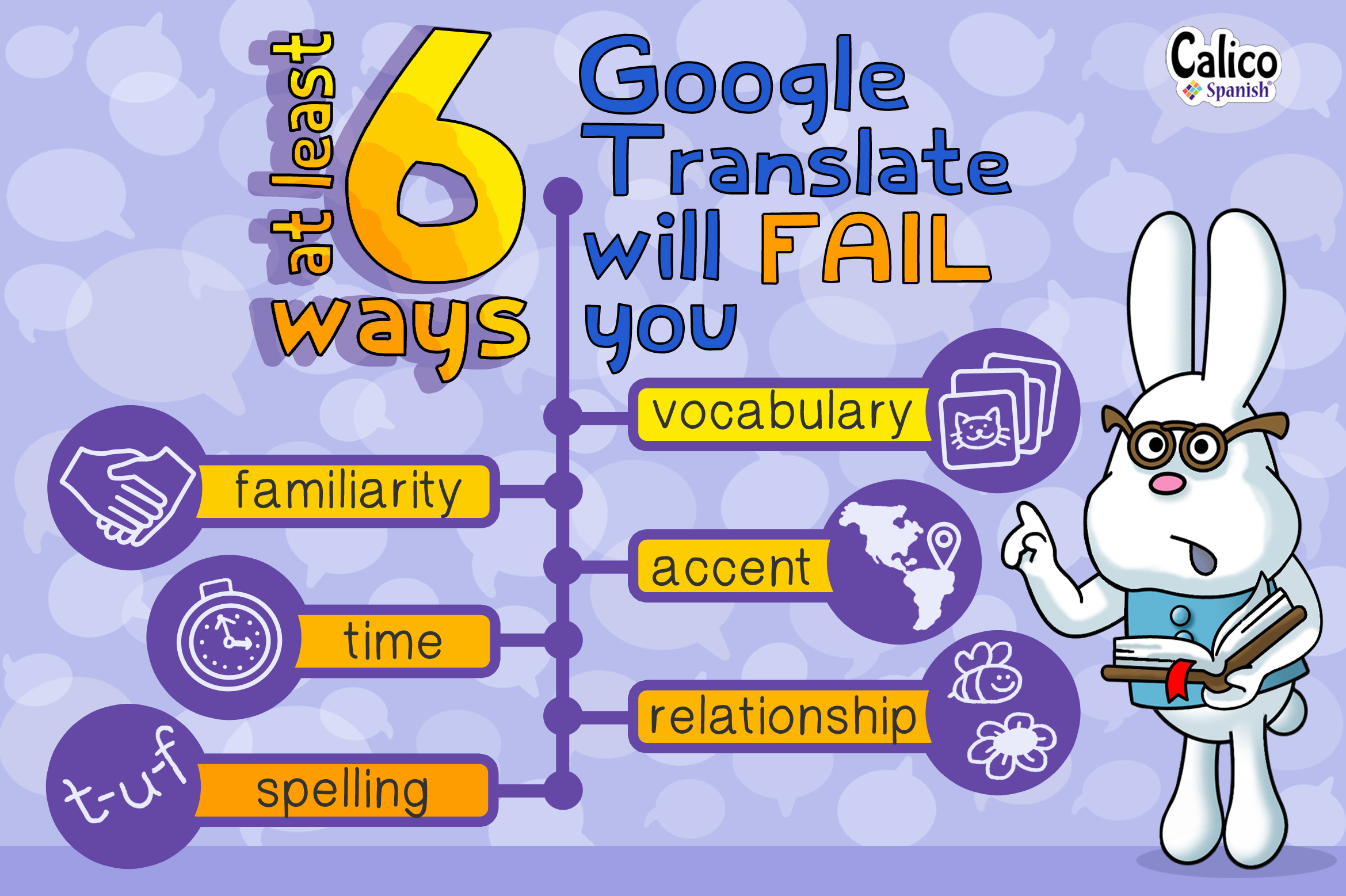Google Translate will fail you (in at least 6 ways)
Thinking Google Translate means you (or your child) won’t need a language learning experience? To be sure, Google Translate has helped us in a lot of ways like enabling language access to local government info, radically improving world travel, and even disseminating COVID-19 information. And every year, the beginning of the school year triggers a slew of language teachers trying to share how “bad” Google Translate is by running a text through several languages and then back into English (because we would do that… when?). There’s no doubt- computers are better all the time, and Google Translate does work, often.
– Follow us on Twitter –
However, make no mistake: if connecting well with people is the point of your language learning journey (and how can it not be?), Google Translate will fail you and actually learning a language is still a whole lot better. Here are a few reasons why- and you can replace “Google Translate” with “Alexa” or any other AI translator throughout. (Don’t get me started on the funky translations Alexa gives my kids, or how I have to pronounce Spanish song names in order for Alexa to actually play them.)
– Like Calico Spanish on Facebook –

1. Google Translate makes you too friendly.
… or not friendly enough.
English doesn’t have a whole lot of formality rules, but other languages do. This means that the language you use with a particular person changes depending on your relationship with that person. It’s a bit like the difference between
Hello, there!
and
Sup, dawg.
(In linguistics we call this ‘register.’) Growing up speaking English, you learned that some phrases are more casual than others (is ain’t a word? yes, and has been for a long time), but English doesn’t really show familiarity in the way words are put together, the way many languages do.
For example, this formality difference shows up mainly in verbs in languages like Spanish. If you go to Google Translate and ask it to change
How are you?
from English to Spanish you get
¿Cómo estás?
which is the informal version. The problem is that if you use that phrase with someone you are supposed to treat formally, you may offend them.
Russian goes so far as to do this with words like “hello” and “goodbye.” The word you use for “hello” to a friend is completely different from the word you use with someone you don’t know. If you type in “hi” or “hey,” you’ll get the informal Привет (privyet). Typing in “hello” will give you the formal version, Здравствуйте (zdrastvootya). Great if you know that just happened, but if you don’t, good luck. I once walked into a Russian foods store and slipped and tried my
Привет!
out on the cashier, who eyed me and icily responded,
Здравствуйте.
Whoops. Point being, learning a language from someone who speaks it can help you avoid these blunders in, let’s face it, the most basic of language. Who doesn’t start their journey learning how to greet people?
– Follow us on Instagram too! –
2. Speech-to-text doesn’t understand your accent.
Speech-to-text is a fantastic invention. By adding the ability to speak the input for Google Translate, the app supposedly became an even faster, more convenient way to get a translation. But is it really?
I live in a very diverse city with a thriving refugee population, including the one of the largest Cuban populations outside of Florida. Recently, I was in the grocery store and a man was trying to get help from an English-speaking woman. I watched for a few minutes as he said,
somethingsuperfastinrapidfireCubanSpanish
into his Translate app. Predictably, the app came up with something completely nonsensical. Good luck, Google, Cuban Spanish is wicked hard for any language learner to get a grasp on, am I right?! So, nothing about this situation worked. More rapid Spanish. More garbled translation. More blank face, searching for how to get out of this confusion.
What did this situation need? Human intervention, of course. I smiled the woman on her way as I asked the man how I could help him, in Spanish. I soon found out he was looking for rabbit food, showed him where it was, and the moral of the story is, without successful language learners, how will the bunnies get fed?
3. Computers don’t know a yard from a garden.

There’s a good reason we were taught “yard” is “jardín” in Spanish. (Colombia) But the U.S. concept is a lot fuzzier.
Waaay back when I studied textbook Spanish, I was taught that the word for “yard,” like your front yard, was jardín. I thought it was curious this was also the word for “garden.” Later, in other textbooks, I learned the word patio, which also seemed a curious word for the green area around my house. As I developed relationships with actual Spanish speakers outside my textbook, I learned that for one thing, a jardín is really a garden, and my Mexican friends call the green expanse in front of their house here a yarda.
The reason for this specific difference is that between the population density, cost of property, weather, and so on, in most Spanish-speaking cultures, a yard is something that doesn’t really exist, not the way we know it here. Why didn’t my textbook tell me that instead of trying to help me navigate the cultural difference? I don’t know – but I can guarantee you Google Translate isn’t doing any better. Try to translate any sentence with “yard” into Spanish and GT will give you el patio, just like my college textbook. Sorry, GT, the courtyard-like patio in colonial-style houses in Quito is nothing like my yarda.
This vocabulary problem is never-ending. If I type in ¿Dónde está mi collar? it dutifully gives me “Where is my necklace?” But what if I’m talking about my dog and I what to know where his collar is, so I say ¿Dónde está su collar? GT tells you what I said was “Where is your necklace?” The problem is that the words for “necklace” and “collar” are the same, but Translate is not yet sensitive enough to read my mind. Nor can I ask it follow up questions to clarify, like,
Te refieres al collar del perro, ¿verdad?
(You’re referring to the dog’s collar, right?)
The more different a language is from English, and/or the newer it is as an addition to Translate, the worse this problem gets. (See, for example, how it doesn’t know the queen from the wife of the king in Africa.) My refugee friends and I have been thrilled to see the addition of Kinyarwanda to Translate, but it didn’t take long for a friend to text me to be VERY careful as some basic language produced very offensive profanity. Good thing we have a young high school-age refugee friend who helps us figure these things out before we get ourselves into big trouble.
4. Google Translate dusn’t hav yer bak
Not great at spelling? Google does not have your back. Let’s stick with “collar” and take, for example, that crazy “er” sound in English that can be spelled with any vowel before the “r” (collar, forever, bird, color, purple). If you ask Google Translate to translate “coler” instead of “color,” with the “Detect Language” function on, and it detects you’re using Welsh and will give you any translation for the English word “collar.”
My daughter got a subscription to Raddish Kids, a cooking subscription box, for Christmas. The first kit’s challenge was to make an Italian restaurant and she went at it with gusto. In the picture on the card in the box, the restaurant’s name was “Il Ravanallo Rosso.” She asked me what it meant, so of course I asked Google Translate to give me that Italian phrase in English. The result? “The Red Ravanallo.” Well, that didn’t make sense. Being a language person, I guessed that they might be going for “The Red Radish.” Sure enough, asking for the Italian for “The Red Radish” gave me Il Ravanello Rosso. The company’s typo of one vowel pretty much negated a non-Italian speaker’s attempt to use GT for help.
The spelling problem goes two ways, actually. The way GT gets better is by using native speakers’ judgments on whether translations are good or not. Part of the reason Google Translate is so bad at some African languages, among others, is that the people who speak those languages may not know or use standardized spelling. This cripples the software’s machine learning mechanisms. So, don’t expect it to get a lot better very quickly.
5. Google Translate is loading…loading…
The fifth way Google Translate is going to fail you is in time and, related, connectivity to the internet. When your son becomes a firefighter and needs to yell questions at the Spanish-speaking family trapped in the house, is going through a translating app the best way to do that? When your daughter is the head chef at her own restaurant and wants to stop the Swahili-speaking waiter on his way out of the kitchen, will GT save the dish? No.
Also, obviously, the app requires cell towers. When a hurricane knocks out communication and you’re rushing in to assess and help with the Red Cross, what will you see on your app? The spinning circle of no connection.
There’s no getting around it: typing or even speaking into an app makes any communication take longer, and requires an internet connection to work (though if you know ahead of time what language you’re likely to be using, the app will let you download it- a key feature I’ve used before). This is one of the key reasons U.S. employers report they need more multilingual employees, not more applicants proficient with Google Translate.
Introduce a child you love to a lifelong journey of speaking real Spanish to real people. Click the red button to experience it FREE.
6. And the greatest of these is… LOVE
Regardless of the technology that comes and goes and changes, the real reason people get proficient at speaking a new language is to connect with the people who speak it, to conduct business, to be a neighbor, to be a friend. Little says “I care about who you really are” like learning enough of someone’s language to speak to them without going through a phone or computer.
As Douglas Hofstadter says in his article for The Atlantic,
Google Translate isn’t familiar with situations, period. It’s familiar solely with strings composed of words composed of letters. It’s all about ultra-rapid processing of pieces of text, not about thinking or imagining or remembering or understanding.
Can we add, it’s not about connecting?
In a world that’s every more disconnected, it’s going to take effort to connect with others. The thing about traveling this road is that almost always, the journey that’s harder to take is the one that’s worth it, the one that leads you to a place of meaning.
If you’re ready to start this journey with a child you love, we’re ready to help. Calico Spanish is committed to providing tools anyone can use to teach children real Spanish for a real future. Discover Stories now.






3 Comments
Honestly, I completely agree with you. Google Translate (or anything auto-generated for that matter) isn’t always accurate. It’s good to know that you can’t use Google Translate accurately 100% of the time.
Glad you liked our post, Michael!
It is a great tool for learning.